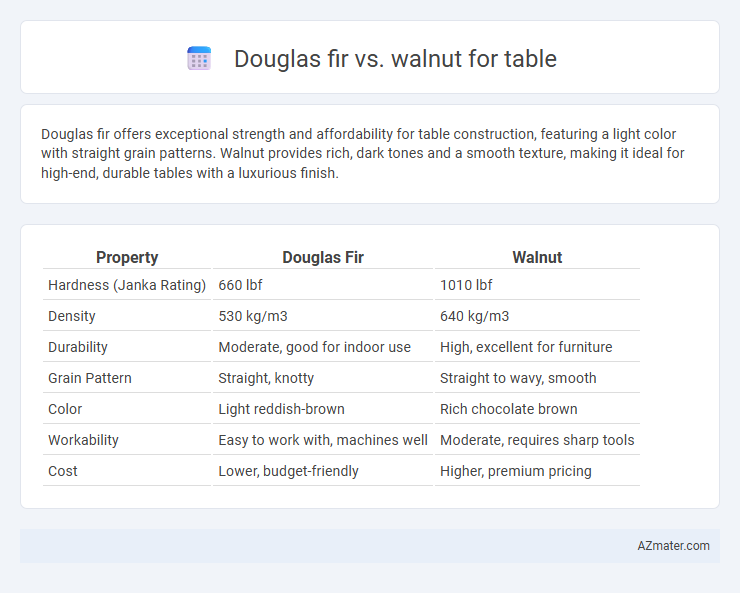Douglas fir offers exceptional strength and affordability for table construction, featuring a light color with straight grain patterns. Walnut provides rich, dark tones and a smooth texture, making it ideal for high-end, durable tables with a luxurious finish.
Table of Comparison
| Property | Douglas Fir | Walnut |
|---|---|---|
| Hardness (Janka Rating) | 660 lbf | 1010 lbf |
| Density | 530 kg/m3 | 640 kg/m3 |
| Durability | Moderate, good for indoor use | High, excellent for furniture |
| Grain Pattern | Straight, knotty | Straight to wavy, smooth |
| Color | Light reddish-brown | Rich chocolate brown |
| Workability | Easy to work with, machines well | Moderate, requires sharp tools |
| Cost | Lower, budget-friendly | Higher, premium pricing |
Introduction to Douglas Fir and Walnut for Tables
Douglas fir is a strong, durable softwood known for its distinctive reddish-brown color and straight grain, making it an excellent choice for sturdy tables with a rustic aesthetic. Walnut, a hardwood prized for its rich, deep brown hues and fine grain, offers elegance and durability, often used for high-end tables that require both beauty and structural integrity. Both woods provide unique visual appeal and functionality, with Douglas fir favored for its affordability and walnut for its luxurious finish.
Visual Appearance: Grain Patterns and Color
Douglas fir features a straight, pronounced grain with knots and a warm, amber to reddish-brown hue that gives tables a rustic and natural charm. Walnut exhibits a rich, dark brown color with occasional purple undertones and a smooth, flowing grain pattern that creates a sophisticated and elegant look. The contrasting grain complexity and color depth of walnut make it ideal for refined furniture, while Douglas fir's vibrant and textured appearance suits casual, cozy interiors.
Hardness and Durability Comparison
Douglas fir, with a Janka hardness rating of approximately 660 lbf, offers moderate hardness suitable for furniture that resists everyday wear but is prone to dents compared to harder woods. Walnut boasts a higher Janka hardness of around 1010 lbf, providing superior resistance to scratches and dents, making it a durable choice for table surfaces. Durability-wise, walnut's dense grain structure enhances longevity and resistance to moisture damage, whereas Douglas fir requires more maintenance to prevent surface wear in high-use environments.
Workability and Ease of Crafting
Douglas fir offers excellent workability due to its straight grain and moderate hardness, making it easy to cut, shape, and sand for table construction. Walnut, while harder and denser, provides smooth carving and polishing but requires sharper tools and more effort during crafting. Choosing Douglas fir facilitates faster assembly and less wear on tools, whereas walnut demands precision but results in a durable, elegant finish.
Cost Differences: Douglas Fir vs Walnut
Douglas fir is significantly more affordable than walnut, with prices often ranging between $2 to $5 per board foot compared to walnut's $10 to $15 per board foot, reflecting differences in availability and demand. The lower cost of Douglas fir makes it a popular choice for budget-friendly tables, while walnut is preferred for high-end, luxury furniture due to its rich color and grain. Cost differences also factor in durability and aesthetic appeal, with walnut commanding a premium for its hardness and unique finish.
Sustainability and Environmental Impact
Douglas fir is a highly sustainable wood option due to its fast growth rate and abundance in North American forests, which supports responsible harvesting and reforestation efforts. Walnut, while prized for its rich color and durability, grows more slowly and is less abundant, often leading to higher environmental impacts related to forest depletion and longer regeneration periods. Selecting Douglas fir over walnut for tables reduces ecological footprints by promoting renewable resources and minimizing deforestation risks.
Maintenance and Longevity
Douglas fir tables require regular sealing and occasional refinishing to protect against moisture and scratches, as the softwood is more prone to dents and wear. Walnut offers superior durability and longevity due to its dense hardwood structure, resisting daily wear with minimal upkeep beyond periodic oiling or waxing. Both woods benefit from avoiding direct sunlight and humidity fluctuations to maintain their appearance and structural integrity over time.
Suitability for Various Table Styles
Douglas fir offers a light, warm tone with prominent grain patterns, making it ideal for rustic and farmhouse-style tables that emphasize natural textures. Walnut features a rich, dark brown color and smooth grain, preferred for elegant, modern, and mid-century designs requiring a sophisticated and refined appearance. Both woods provide durability and stability, but the choice depends on the desired aesthetic and table style prominence.
Finishing Options and Aesthetic Enhancement
Douglas fir offers a smooth surface ideal for clear finishes, which highlight its warm, reddish-brown tones and prominent grain patterns, creating a natural rustic appeal. Walnut's dense, fine grain absorbs oils and stains evenly, enhancing its rich, dark chocolate hues and providing a luxurious, polished aesthetic suitable for high-end tables. Both woods respond well to polyurethane and varnish but Walnut's deeper coloration benefits significantly from oil finishes that enrich its natural luster and depth.
Final Recommendation: Which Wood for Your Table?
Walnut offers a rich, dark color and natural durability ideal for high-end tables that emphasize elegance and longevity. Douglas fir features a lighter hue with a straight grain, providing affordability and strength suitable for rustic or casual table designs. Choose walnut for premium craftsmanship and lasting beauty, while Douglas fir is preferred for cost-effective, sturdy tables with a warm, natural appearance.

Infographic: Douglas fir vs Walnut for Table
 azmater.com
azmater.com